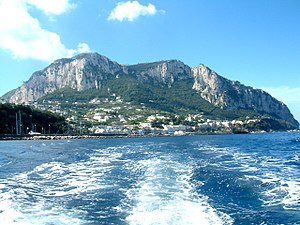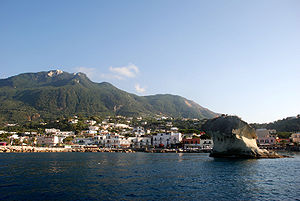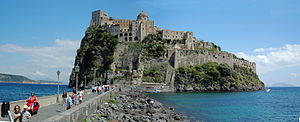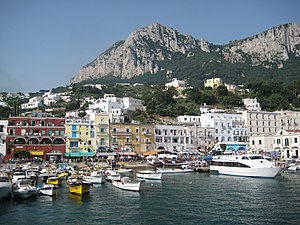![Lacco Ameno, Ischia, Italy. Monte Epomeo in th... Lacco Ameno, Ischia, Italy. Monte Epomeo in th...]()
- Image via Wikipedia
In southern Italy, Campania is one of Italy’s most captivating scenic regions. It is nestled around the Bay of Naples and Mt. Vesuviuswith incredible panoramic views. The smoldering volcano that destroyed Pompeii and Herculaneum created fertile soil for growing grapes, lemons, olives and flowers.

A map showing the cities and towns affected by the eruption of Mount Vesuvius in 79 AD. The general shape of the ash and cinder fall (see en:pyroclast) is shown by the dark area to the southeast of Mt Vesuvius. (P.S. It seems strange to show the modern day English names for the two bodies of water – I am open to suggestions). This map shows lines and uses the Mercator projection (although that is not important on a map of this scale). North is, as usual, at the top of the map. (Photo credit: Wikipedia)

English: Capri, Campania, Italy. View from Monte Solaro, with the town of Capri in the foreground, and the Sorrento Peninsula on the horizon. Français : Capri, Campanie, Italie. Vue depuis le mont Solaro, avec la ville de Capri au premier plan, et la péninsule de Sorrento à l’horizon. (Photo credit: Wikipedia)
Campania has one of the most beautiful coastlines in Italy. The regional champions are Capri, Sorrento, Ischia and Procida in the Gulf of Napoli. Witness the remains of the glory days of the Roman Empire in Herculaneum, Pompeii,, and Paestum. Gaze at triumphal arches and massive amphitheaters.

POMPEII, ITALY – NOVEMBER 14: Pompeii’s ruins in front the Gulf of Naples on November 14, 2010 in Pompeii, Italy. Pompeii is a partially buried Roman town-city near modern Naples. The Schola Armatorum, a 2,000-year-old House of the Gladiators, collapsed November 6, 2010, exposing the perilous state of the historical city. The area was declared a World Heritage Site by UNESCO in 1997. (Image credit: Getty Images via @daylife)
When Vesuvius erupted on August 24th in the year A.D. 79, it engulfed the two flourishing Roman towns of Pompeii and Herculaneum. The area had already sustained a damaging earthquake in A.D. 69. Pompeii is about six miles south-east of Mt. Vesuvius’ crater and it has erupted about 50 times since it devastated the town of Pompeii. Many of the wealthy villas in the area were destroyed. The site was discovered during excavations for a canal in the 16th century.
Pompeii’s excavation progressed slowly and the site was made accessible to the public in the mid-18th century. Imagine walking the streets and patronizing the shops of the ancient Roman elliptical town. Get a personal or audio guide to fully appreciate first century Roman life.
The Archeological sites of Paestum were originally built by Greek colonists from Sybaris around 600 B.C. When the Greeks founded the town they named it Poseidonia (Poseidon). Paestum is one of Italy’s most impressive archeological sites. Visit the three Doric Greek temples. Athena’s temple is the smallest, Hera’s is the oldest and the imposing temple of Neptune is the largest temple. The Temple of Neptune (Poseidon) is the best preserved Greek temple in the world and is 200 feet long.
The site is located about 25 miles south of Salerno. It was excavated in the 18th century when the ruins were discovered by local road builders. It includes a Roman forum, civic buildings and an amphitheater. Visit the “Heroon” with a tomb and a stone chamber that dates back to the 6th century B.C. Buy a combination ticket for the site and archeological museum. The museum has outstanding examples of tomb paintings, decorations and sculptures from the area’s excavations.

English: Marina Grande, Capri, Campania, Italy. On the horizon, the islands of Ischia and Procida, and the Gulf of Naples. Français : Marina Grande, Capri, Campanie, Italie. À l’horizon, les îles d’Ischia et Procida, et la baie de Naples. (Photo credit: Wikipedia)
Ischia is an island in the Gulf of Naples. Charming houses line the crater-filled lake on this emerald island. It is the largest island in Campania and the Gulf of Naples.
Greeks landed in Ischia in the 8th century B.C. It was the perfect base for them to reach the mainland. Today it is a huge resort with sandy beaches and more than 50 mineral springs. The thermal springs are generated by the heat from the extinct volcano Monte Epomeo. Mount Epomeo has a summit of 2,585 feet and the summit is the highest point on the island. The volcano has not erupted since the 14th century.
Ischia is called the Island of Eternal Youth because it has more than 150 spas and curative thermal springs. The Roman Emperor Caesar Augustus traded land with the Neapolitans; he swapped Ischia for the smaller island of Capri in 29 B.C.
For the best view, visit the island’s most historical site, the imposing Aragonese Castle. It was used as a defensive refuge from marauding pirates. The Greeks had a fortress on this strategic spot before it became a castle. The Greeks decided to abandon the island because they were fed up with earthquakes and Mt. Epomeo’s repeated eruptions. Disembark from the Marina to begin your adventure.
Capri is Italy’s most famous island. Capri borders the southern edge of the Bay of Naples, where dolomite cliffs soar above the tip of the Sorrento peninsula.
The naughty Roman Emperor Tiberius built 12 villas in Capri and dedicated them to the 12 gods of Olympus: Zeus, Hera, Poseidon, Demeter, Athena, Hestia or Dionysus, Apollo, Artemis, Ares, Aphrodite, Hephaestus and Hermes.
His most impressive residence was his imperial 1stcentury party villa called Villa Jovis.

English: Capri, Campania, Italy. View from the chairlift between Monte Solaro and the town of Anacapri. On the horizon, the Gulf of Naples. Français : Capri, Campanie, Italie. Vue depuis le télésiège entre le mont Solaro et la ville d’Anacapri. À l’horizon, la baie de Naples. (Photo credit: Wikipedia)
It is rumored that the Greeks named Capri after the Greek word for wild goats “kapriae.” Anacapri is perched high above the town of Capri. Take the chairlift from Anacapri to Monte Solaro and gaze at the Vino con Vista panorama.

Barbarossa Castle in Capri still carries the name of the Ottoman admiral who captured the island in 1535. The Turks eventually departed from Capri, but another famous Ottoman admiral, Turgut Reis, recaptured both the island and the castle in 1553. (Photo credit: Wikipedia)
The rocky island of Capri has sweeping vistas, caves, limestone houses with terraced roofs and lush Mediterranean gardens. Mount Tiberio and Mount Solaro are the main peaks on the island. It is also home to the Blue Grotto marine cave nestled in the famous Faraglioni sea stacks on the western side of the island. The sea stacks rise from the Tyrrhenian Seaand are the natural habitat of rare blue lizards. According to legend, the Roman Emperor Tiberius used the grotto as a personal spa. A boat ride around the island from the Marina puts this heavenly destination into perspective.

English: Map of Capri. Uses terrain data from SRTM3 (http://dds.cr.usgs.gov/srtm/version2_1/SRTM3/Eurasia/N40E014.hgt.zip). Bitmap version of File:Capri_sights_terrain.svg. Note: An offical map of Capri (with roads, etc.) can be found at http://www.capritourism.com/imgg/download/capri_map_en.pdf (Photo credit: Wikipedia)
Sorrento is situated on a terraced plain above the sea with spectacular views of Vesuvius, Ischia and the Bay of Naples. This enchanting location makes it the perfect destination for exploring this region via watercraft from the marina. Choosing a base for your travels depends on your priorities, timetable and budget.
The 18th century Royal Palace of Caserta became a UNESCO World Heritage Site in 1997. Caserta is north of Naples on the Tyrrhenian Coast near the Lazio border. It has a medieval old town and an elegant Bourbon palace. The wine region is concentrated at the northern end of the Campania region between Mount Massico and the extinct volcano Roccamonfina www.comune.caserta.it.

Photograph of the Caserta Palace facade taken form piazza Carlo III,a grand courtyard in front of the building. (Photo credit: Wikipedia)

Caserta, Reggia di Caserta. Appartamento nuovo del Re. Sala di Astrea. È una delle tre sale dell’Appartamento reale assieme alla Sala di Marte e alla Sala del Trono. (Photo credit: Wikipedia)
The Royal Palace and Park of Caserta: The opulent complex at Caserta was constructed for the Bourbon Kings of Naples in the 18th century with elaborate Baroque gardens. The Royal Family wanted to create an estate that would rival Versailles in France and the Royal Palace in Madrid. The Baroque Palazzo Reale and the aqueduct that feeds the fountains were designed by Luigi Vanvitelli, court architect for Bourbon King Charles of Naples. He wanted to build a palace in a defensible location that could be protected from enemy attacks by sea. It has more than 1,000 elaborately adorned rooms and grand staircases. In 1945, the Germans signed surrender documents at Caserta.
In Campania enjoy the Mozzarella di Bufala, and the outstanding pizza. Limoncello and crema di limone are lemon-based specialty beverages in tihs region. Try some local wine; Lacryma Christi, or “Tears of Christ.” This wine is produced on the lower slopes of Mount Vesuvius.
Many of the hotels in this region are seasonal so be sure to book your trip soon.

Dr. EveAnn Lovero writes Travel Guides @ www.vino-con-vista.com
Related articles
Filed under: Ancient Rome, Apple Products including iPad, Capri, ebooks, Greek Theater, IPad, Italian Architecture, Italian art, Italian Cheese, Italian Food, Italian Food and Wine, Italian Wine, Italy, Italy Travel Guides, Restaurants in Italy, Roman Architecture, Roman Emperors, Rome History, Sorrentine Penninsula, Travel and Tourism, UNESCO, vino con vista, Volcano, World Heritage Sites Tagged: Bay of Naples, Campania, Capri, Ebooks about Italy, Gulf of Naples, Ischia, Italy, Mount Epomeo, Naples, Paestum, Roman Empire, Travel and Tourism, vino con vista, World Heritage Site, World Heritage Sites in Italy















































